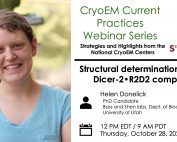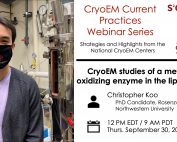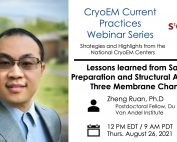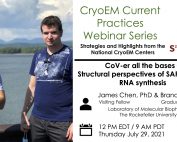CryoEM Current Practices Webinar 10/28/2021
The next installment of the monthly methods-focused webinar series hosted by the National Center for CryoEM Access and Training (NCCAT), along with the Pacific Northwest Center for CryoEM (PNCC), and the Stanford-SLAC CryoEM Center (S2C2) will be held on Thursday October 28, 2021 at 12 PM eastern / 9 AM pacific time Helen Donelick, PhD candidate in the Bass and Shen Labs, Department of Biochemistry, University of Utah will present Structural determination of the Dicer-2•R2D2 complex Talk Abstract: The ability to fight a viral infection is essential for all organisms. Drosophila melanogaster utilizes RNA interference for the antiviral response. Here, the protein, Dicer-2, is used for small interfering RNA (siRNA) biogenesis and passing one strand of the siRNA into Argonaute-2 to form the [...]
CryoEM Current Practices Webinar 09/30/2021
The next installment of the monthly methods-focused webinar series hosted by the National Center for CryoEM Access and Training (NCCAT), along with the Pacific Northwest Center for CryoEM (PNCC), and the Stanford-SLAC CryoEM Center (S2C2) will be held on Thursday September 30, 2021 at 12 PM eastern / 9 AM pacific time Christopher Koo, PhD candidate in the Interdisciplinary Biological Sciences Program (IBiS), Rosenzweig Lab, Depts. of Molecular Biosciences and Chemistry, Northwestern University will present CryoEM studies of a methane-oxidizing enzyme in the lipid bilayer Talk Abstract: CryoEM has revolutionized structural studies of membrane proteins over the last decade. Combined with membrane mimetics such as lipid nanodiscs, cryoEM allows for detergent-free structural determination of membrane proteins within a lipid bilayer more [...]
CryoEM Current Practices Webinar 08/26/2021
The next installment of the monthly methods-focused webinar series hosted by the National Center for CryoEM Access and Training (NCCAT), along with the Pacific Northwest Center for CryoEM (PNCC), and the Stanford-SLAC CryoEM Center (S2C2) will be held on Thursday August 26, 2021 at 12 PM eastern / 9 AM pacific time Zheng Ruan, Ph.D. from the Du and Lü Labs at Van Andel Institute will present: Lessons learned from Sample Preparation and Structural Analysis of Three Membrane Channels Talk Abstract: Sample preparation and data analysis are important steps in achieving high-resolution cryo-EM structures. In this talk, I will discuss the lessons and tips that I learned while studying three different membrane channels, including the proton-activated chloride channel (PAC), pannexin 1 [...]
CryoEM Current Practices Webinar 07/29/2021
The next installment of the monthly methods-focused webinar series hosted by the National Center for CryoEM Access and Training (NCCAT), along with the Pacific Northwest Center for CryoEM (PNCC), and the Stanford-SLAC CryoEM Center (S2C2) will be held on Thursday July 29, 2021 at 12 PM eastern / 9 AM pacific time James Chen, Ph.D. & Brandon Malone from the Laboratory of Molecular Biophysics, The Rockefeller University will present: CoV-er all the bases - Structural perspectives of SARS-CoV-2 RNA synthesis Talk Abstract: The COVID-19 pandemic has claimed millions of lives and devastated the world economy. Garnering insights into the replication cycle of the causative agent, SARS-CoV-2, will aid the development of therapeutics. SARS-CoV-2 possesses one of the largest viral RNA genomes [...]
CryoEM Current Practices Webinar 06/24/2021
The next installment of the monthly methods-focused webinar series hosted by the National Center for CryoEM Access and Training (NCCAT), along with the Pacific Northwest Center for CryoEM (PNCC), and the Stanford-SLAC CryoEM Center (S2C2) will be held on Thursday June 24, 2021 at 12 PM eastern / 9 AM pacific time Dr. Aashish Manglik, Assistant Professor, Depts. of Pharmaceutical Chemistry & Anesthesia and Perioperative Care University of California, San Francisco will present: Solving molecular puzzles in GPCR signaling with cryo-EM Talk Abstract: Cryo-EM has revolutionized structural studies of G protein-coupled receptors over the past few years. More facile structure determination of active GPCRs has enabled the field to understand the molecular basis of receptor function at an unprecedented pace. I [...]





